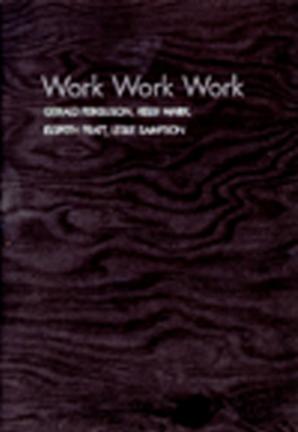 Home Exhibitions MSVU Collection Publications Posters Working Title Resources
Home Exhibitions MSVU Collection Publications Posters Working Title Resources
|
Home » Publications » Catalogue Excerpts » Work Work Work
Work Work Work   Purchase the catalogue Purchase the catalogueGo to the exhibitionís webpage... Introduction Visual artists are constantly in dialogue with vernacular practices. Work Work Work offers a glimpse of the dialogue as it looked ten to fifteen years ago, in the wake of Conceptual Artís radical deskilling and amateurization of the professional artist. The artists of Work Work Work present their art as the product of labour which may not be entirely theirs, or which mimics mundane sorts of work. Often it is the toil of handymen and homemakers that shines through some barely transformed item incorporated into the work of art. The artistís labour of assemblage or at most, of altering a surface with homely handwork like cross-stitch embroidery and stencil, seems to defy the technical expertise and sophisticated vision that have traditionally set certain makers apart as “artists.” This selection of works proposes that some approaches to artmaking intentionally imitate artisanal production, home renovation or the household arts. The artists deploy bricolage (making do with whatever is at hand) and appropriation (lifting images and objects from other contexts) to confront the elite category of art with overtly classed and gendered categories of work. Through this confrontation the social devaluation of many forms of work - including art work - becomes apparent. It may also be tempting to compare the artistsí implied motivations for working, such as obsessiveness, love of routine, or puttering, with those of non-specialized makers. In Leslie Sampsonís work the choice of craft techniques as opposed to those associated with visual art is strategic. It counter-states the disparagement of the crafts in contemporary visual art and situates artisanal activity at a distance from capitalist coercion, as a form of autonomous labour that paradoxically extends the autonomous realm of art production. Whereas Sampson makes no secret of her skills as a carpenter, Prattís crude wooden box sketches a parodic stereotype of amateur incompetenceóthe woman in the wood shop. Yet both artists function within a gendered framework to distinguish traditional aesthetic criteria, such as technical virtuosity, from the transformative acts of imagination that animate their objects as art.
In the context of Work Work Work, with its predominance of women artists, the news is less dire. After all, renouncing the great traditions of Western art can hardly be treated as a sacrifice on the part of women. I would suggest, instead, that the exhibition offers a playful invitation to confuse work with recreation-a purpose that in the modern age was transferred from professional artmaking to folk art. Together the makeshift objects of Work Work Work dream their dream, the vision of an unalienated day at work. |